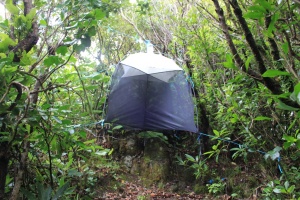Summary:
The Azorean Biodiversity Group started an unprecedented collaboration with several Azorean environmental organizations to perform a Long Term Ecological Study in the natural forest of several Azorean islands - See more at: http://www.gba.uac.pt/noticias/ver.php?id=135#sthash.VKPqBMF4.dpuf
This study aims to monitor the flying insect fauna to monitor the impact of climatic changes in the productivity of Azorean native forests. We aim to monitor these forests four times per year following the seasonal variation during the next 5 years within the 2020 Horizon.
For that we setup SLAM traps (see Attached Figure) in the following areas: Pico Alto at St. Maria island; Graminhais, Tronqueira and Furnas at S. Miguel Island; Galhardo, Caldeira St. Bárbara, Terra-Brava and Rocha do Chambre at Terceira Island; Caldeira, Cabeço do Fogo and Pedro Miguel at Faial island; Caveiro, Lagoa do Caiado and Mistério da Prainha at Pico island; Caldeira Funda and Morro Alto in Flores,and now in Caldeira and Caldeirinhas in Graciosa.
The traps in Terceira are already operating since 2012 within the Project NETBIOME ISLANDBIODIV. In the other islands the study started in August-September 2013
- See more at: http://www.gba.uac.pt/noticias/ver.php?id=135#sthash.VKPqBMF4.dpuf
A total of 24 SLAM traps are distributed in several native forest plots in seven Azorean Islands with SLAM traps, aiming to investigate the seasonal and between year variations of the biomass of flying insects. With the current framework it will be possible to address the following questions:
1) collect long-term ecological data to evaluate species distributions and abundance at multiple spatial and temporal scales;
2) identify pathways impacting oceanic indigenous assemblages under global change for conservation purposes,
3) islands are especially good places to investigate species-environment relationships, and we aim to use species distribution and abundance data in model-based studies of environmental change in different islands;
4) perform studies of the relationship between diversity (taxonomic, functional and phylogenetic) and ecosystem function.
Funding Institution:
NETBIOME _ISLANBIODIV; and Student Grants from EU Eurodyssee Project and EU -ERASMUS Training
Partners:
Natural Parks of Santa Maria, Terceira, Faial, Pico, Flores, Graciosa, SPEA, the Botanical Garden of Faial and the Furnas Monitoring and Research Centre
Photos Gallery:




